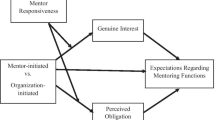Abstract
This study examined whether the structural attributes of a formal mentoring program and/or certain demographic characteristics of participants in the program influence protege satisfaction. Proteges, employed in a traditionally male occupation, were sampled from a federal agency's mentoring program. According to policy, the agency attempted to assign proteges to one of three mentors they previously requested. An internally-developed measure, designed to assess protege satisfaction, was distributed after their completion in the program. A total of 565 surveys were received from 1998 to 2000. Results indicated that feedback in the assignment process and the frequency of meetings between the protege and mentor were more important determinants of protege satisfaction than racial and gender differences between proteges and the dyad.
Similar content being viewed by others
references
Burke, R. J., & McKeen, C. A. (1989). Developing formal mentoring programs in organizations. Business Quarterly, 53(3), 76–99.
Burke, R. J., McKeen, C. A., & McKenna, C. (1993). Correlates of mentoring in organizations: The mentor's perspective. Psychological Reports, 72(3), 883–896.
Byrne, D. (1971). The attraction paradigm. New York: Academic Press.
Chao, G. T., Walz, P. M., & Gardner, P. D. (1992). Formal and informal mentorships: A comparison on mentoring functions and contrast with non-mentored counterparts. Personnel Psychology, 45, 619–636.
Dreher, G. F., & Ash, R. A. (1990). A comparative study of mentoring among men and women in managerial, professional, and technical positions. Journal of Applied Psychology, 75(5), 539–546.
Ensher, E. A., & Murphy, S. E. (1997). Effects of race, gender, perceived similarity, and contact on mentor relationships. Journal of Vocational Behavior, 50, 460–481.
Fagenson, E. A. (1989). The mentor advantage: Perceived career/job experiences of proteges versus non-proteges. Journal of Organizational Behavior, 10, 309–320.
Guadagnoli, E., & Velicer, W. F. (1988). Relation to sample size to the stability of component patterns. Psychological Bulletin, 103(2), 265–275.
Kram, K. E. (1985). Mentoring at work: Developmental relationships in organizational life. Glenview, IL: Scott, Foresman.
Noe, R. A. (1988). An investigation of the determinants of successful assigned mentoring relationships. Personnel Psychology, 41, 457–478.
Pedhazur, E. J., & Schmelkin, L. P. (1991). Measurement, design, and analysis: An integrated approach. Hillsdale, NJ: Lawrence Erlbaum Associates, Inc.
Ragins, B. R. (1997). Antecedents of diversified mentoring relationships. Journal of Vocational Behavior, 51, 90–109.
Ragins, B. R., & Cotton, J. L. (1999). Mentor functions and outcomes: A comparison of men and women in formal and informal mentoring relationships. Journal of Applied Psychology, 84, 529–550.
Ragins, B. R., Cotton, J. L., & Miller, J. S. (2000). Marginal mentoring: The effects of type of mentor, quality of relationship, and program design on work and career attitudes. Academy of Management Journal, 43(6), 1177–1194.
Scandura, T. A. (1998). Dysfunctional mentoring relationships and outcomes. Journal of Management, 24(3), 449–467.
Spector, P. E. (1992). Summated rating scale construction: An introduction. Sage University Paper series on Quantitative Applications in the Social Sciences, series no. 07–082. Newbury Park, CA: Sage.
Turban, D. B., & Jones, A. P. (1988). Supervisor subordinate similarity: Types, effects, and mechanisms. Journal of Applied Psychology, 73(2), 228–234.
Author information
Authors and Affiliations
Corresponding author
About this article
Cite this article
Lyons, B.D., Oppler, E.S. The Effects of Structural Attributes and Demographic Characteristics on Protege Satisfaction in Mentoring Programs. Journal of Career Development 30, 215–229 (2004). https://doi.org/10.1023/B:JOCD.0000015541.69028.0a
Issue Date:
DOI: https://doi.org/10.1023/B:JOCD.0000015541.69028.0a




